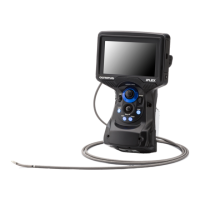Chapter 3 Preparation and Inspection
63
EVIS LUCERA GIF/CF/PCF TYPE 260 Series OPERATION MANUAL
3.2 Inspection of the endoscope
Clean and disinfect or sterilize the endoscope as described in the
“REPROCESSING MANUAL” with your endoscope model listed on the cover.
Then remove the water-resistant cap from the endoscope connector.
Inspection of the endoscope
1.
Inspect the control section and the endoscope connector for excessive
scratching, deformation, loose parts, or other irregularities.
2. Inspect the boot and the insertion section near the boot for bends, twists, or
other irregularities.
3. Inspect the external surface of the entire insertion section including the
bending section and the distal end for dents, bulges, swelling, scratches,
holes, sagging, transformation, bends, adhesion of foreign bodies, missing
parts, protruding objects, or other irregularities.
4. Holding the control section with one hand, carefully run your other hand
back and forth over the entire length of the insertion section (see Figure
3.2). Confirm that no objects or metallic wire protrude from the insertion
section. Also, confirm that the insertion tube is not abnormally rigid.
Figure 3.2
5. Using both hands, bend the insertion tube of the endoscope into a
semicircle. Then, moving your hands as shown by the arrows in Figure 3.3,
confirm that the entire insertion tube can be smoothly bent to form a
semicircle and that the insertion tube is pliable. When inspecting
endoscopes with flexibility adjustment, perform the test with the insertion
section at both its most flexible and most rigid settings (for endoscopes with
flexibility adjustment only).

